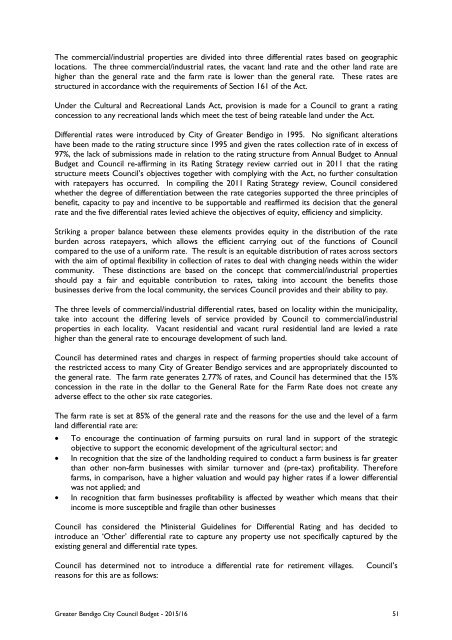City of Greater Bendigo Budget 2015/2016
The Budget for 2015/2016 will help build a better, healthier and more sustainable Greater Bendigo.
The Budget for 2015/2016 will help build a better, healthier and more sustainable Greater Bendigo.
You also want an ePaper? Increase the reach of your titles
YUMPU automatically turns print PDFs into web optimized ePapers that Google loves.
The commercial/industrial properties are divided into three differential rates based on geographic<br />
locations. The three commercial/industrial rates, the vacant land rate and the other land rate are<br />
higher than the general rate and the farm rate is lower than the general rate. These rates are<br />
structured in accordance with the requirements <strong>of</strong> Section 161 <strong>of</strong> the Act.<br />
Under the Cultural and Recreational Lands Act, provision is made for a Council to grant a rating<br />
concession to any recreational lands which meet the test <strong>of</strong> being rateable land under the Act.<br />
Differential rates were introduced by <strong>City</strong> <strong>of</strong> <strong>Greater</strong> <strong>Bendigo</strong> in 1995. No significant alterations<br />
have been made to the rating structure since 1995 and given the rates collection rate <strong>of</strong> in excess <strong>of</strong><br />
97%, the lack <strong>of</strong> submissions made in relation to the rating structure from Annual <strong>Budget</strong> to Annual<br />
<strong>Budget</strong> and Council re-affirming in its Rating Strategy review carried out in 2011 that the rating<br />
structure meets Council’s objectives together with complying with the Act, no further consultation<br />
with ratepayers has occurred. In compiling the 2011 Rating Strategy review, Council considered<br />
whether the degree <strong>of</strong> differentiation between the rate categories supported the three principles <strong>of</strong><br />
benefit, capacity to pay and incentive to be supportable and reaffirmed its decision that the general<br />
rate and the five differential rates levied achieve the objectives <strong>of</strong> equity, efficiency and simplicity.<br />
Striking a proper balance between these elements provides equity in the distribution <strong>of</strong> the rate<br />
burden across ratepayers, which allows the efficient carrying out <strong>of</strong> the functions <strong>of</strong> Council<br />
compared to the use <strong>of</strong> a uniform rate. The result is an equitable distribution <strong>of</strong> rates across sectors<br />
with the aim <strong>of</strong> optimal flexibility in collection <strong>of</strong> rates to deal with changing needs within the wider<br />
community. These distinctions are based on the concept that commercial/industrial properties<br />
should pay a fair and equitable contribution to rates, taking into account the benefits those<br />
businesses derive from the local community, the services Council provides and their ability to pay.<br />
The three levels <strong>of</strong> commercial/industrial differential rates, based on locality within the municipality,<br />
take into account the differing levels <strong>of</strong> service provided by Council to commercial/industrial<br />
properties in each locality. Vacant residential and vacant rural residential land are levied a rate<br />
higher than the general rate to encourage development <strong>of</strong> such land.<br />
Council has determined rates and charges in respect <strong>of</strong> farming properties should take account <strong>of</strong><br />
the restricted access to many <strong>City</strong> <strong>of</strong> <strong>Greater</strong> <strong>Bendigo</strong> services and are appropriately discounted to<br />
the general rate. The farm rate generates 2.77% <strong>of</strong> rates, and Council has determined that the 15%<br />
concession in the rate in the dollar to the General Rate for the Farm Rate does not create any<br />
adverse effect to the other six rate categories.<br />
The farm rate is set at 85% <strong>of</strong> the general rate and the reasons for the use and the level <strong>of</strong> a farm<br />
land differential rate are:<br />
• To encourage the continuation <strong>of</strong> farming pursuits on rural land in support <strong>of</strong> the strategic<br />
objective to support the economic development <strong>of</strong> the agricultural sector; and<br />
• In recognition that the size <strong>of</strong> the landholding required to conduct a farm business is far greater<br />
than other non-farm businesses with similar turnover and (pre-tax) pr<strong>of</strong>itability. Therefore<br />
farms, in comparison, have a higher valuation and would pay higher rates if a lower differential<br />
was not applied; and<br />
• In recognition that farm businesses pr<strong>of</strong>itability is affected by weather which means that their<br />
income is more susceptible and fragile than other businesses<br />
Council has considered the Ministerial Guidelines for Differential Rating and has decided to<br />
introduce an ‘Other’ differential rate to capture any property use not specifically captured by the<br />
existing general and differential rate types.<br />
Council has determined not to introduce a differential rate for retirement villages.<br />
reasons for this are as follows:<br />
Council’s<br />
<strong>Greater</strong> <strong>Bendigo</strong> <strong>City</strong> Council <strong>Budget</strong> - <strong>2015</strong>/16 51


















